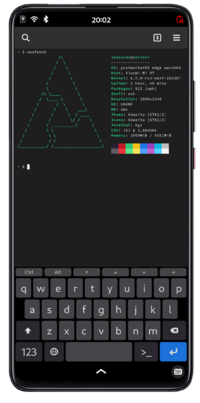Xiaomi Mi 9T / Redmi K20 (xiaomi-davinci)
| This device is supported as part of a generic port. Refer to Generic SM7150 (qcom-sm7150) for installation instructions and more information. |
 Xiaomi Mi 9T / Redmi K20 | |
| Manufacturer | Xiaomi |
|---|---|
| Name |
Mi 9T Redmi K20 |
| Codename | xiaomi-davinci |
| Model |
|
| Released | 2019 |
| Type | handset |
| Hardware | |
| Chipset | Qualcomm Snapdragon 730 (SM7150-AA) |
| CPU |
Octa-core (2x 2.2 GHz Kryo 470 Gold 6x 1.8 GHz Kryo 470 Silver) |
| GPU | Adreno 618 |
| Display | 1080 x 2340 AMOLED |
| Storage | 64/128/256 GB |
| Memory | 6 GB |
| Architecture | aarch64 |
| Software | |
Original software The software and version the device was shipped with. |
Android (MIUI) 9 (MIUI 10) (Linux kernel 4.14.83) |
Extended version The most recent supported version from the manufacturer. |
Android (MIUI) 11 (MIUI 12) (Linux kernel 4.14.180) |
| FOSS bootloader | partial |
| postmarketOS | |
| Category | community |
Mainline Instead of a Linux kernel fork, it is possible to run (Close to) Mainline. |
yes |
pmOS kernel The kernel version that runs on the device's port. |
Mainline 6.17.0-rc7 |
Unixbench score Unixbench Whetstone/Dhrystone score. See Unixbench. |
5923.2 |
| Generic port | Generic SM7150 (qcom-sm7150) |
| Device package |
|
| Kernel package |
|
Flashing Whether it is possible to flash the device with pmbootstrap flasher. |
Works
|
|---|---|
USB Networking After connecting the device with USB to your PC, you can connect to it via telnet (initramfs) or SSH (booted system). |
Works
|
Internal storage eMMC, SD cards, UFS... |
Works
|
Battery Whether charging and battery level reporting work. |
Partial
|
Screen Whether the display works; ideally with sleep mode and brightness control. |
Works
|
Touchscreen |
Works
|
| Multimedia | |
3D Acceleration |
Works
|
Audio Audio playback, microphone, headset and buttons. |
Partial
|
Camera |
Partial
|
Camera Flash |
Works
|
| Connectivity | |
WiFi |
Works
|
Bluetooth |
Works
|
GPS |
Partial
|
NFC Near Field Communication |
Works
|
| Modem | |
Calls |
Works
|
SMS |
Works
|
Mobile data |
Works
|
| Miscellaneous | |
FDE Full disk encryption and unlocking with unl0kr. |
Works
|
USB OTG USB On-The-Go or USB-C Role switching. |
Works
|
| Sensors | |
Accelerometer Handles automatic screen rotation in many interfaces. |
Works
|
Magnetometer Sensor to measure the Earth's magnetism |
Works
|
Ambient Light Measures the light level; used for automatic screen dimming in many interfaces. |
Works
|
Proximity |
Works
|
Haptics |
Works
|
Secondary Bootloader Whether it is possible to chainload U-Boot from stock bootloader. |
Works
|
|---|---|
Mainline Whether latest upstream versions of U-Boot are not broken and it is possible to use them. |
Works
|
Internal Storage Whether it is possible to boot from internal storage (e.g. eMMC or UFS). |
Works
|
USB Host Whether it is possible to boot from a USB storage or connect a keyboard. |
Partial
|
USB Peripheral Whether it is possible to use device as a peripheral in U-Boot, e.g. for fastboot mode. |
Works
|
Display |
Works
|
Buttons Whether it is possible to navigate in boot menu or grub with volume and power buttons. |
Works
|
| This device is based on the Snapdragon 730. See the SoC page for common tips, guides and troubleshooting steps |
Maintainer(s)
Users owning this device
- Adrian (Notes: woop woop)
- Angelthorns (Notes: postmarketOS)
- ArianK16a (Notes: M1903F10G, 6/128, LineageOS 21)
- Kcxt (Notes: Adrian's bricked device)
- MaryJohanna420 (Notes: backup/development device)
- Oreeeee (Notes: Daily driver, LineageOS)
- Recorvus (Notes: mainline)
How to enter flash mode
- Bootloader: Power on the device with both and buttons.
- Recovery: Power on the device with both and buttons.
- Fastbootd: Reboot into bootloader mode first and then run
fastboot reboot fastbootfrom a computer.
Installation
See Generic SM7150 (qcom-sm7150).
Bootloader
You can get rid of a couple of modifications Xiaomi made to the bootloader by running fastboot erase logo. Notably, you get a fastboot menu that can be navigated with volume buttons, to e.g. shut down the device from there.
Quirks
This should provide a rough overview explaining some unexpected things in the feature support table in the infobox.
Battery
It charges, but very slowly since the hardware charger is not supported yet and especially the fuel gauge implementation is very basic and inaccurate.
Audio
Speaker audio works, microphone and earpiece are not working due to missing WCD implementation in the kernel.
Camera
The tele and ultrawide sensors are supported by our kernel fork and probing fine, but the camss is not implemented yet, making it impossible to take pictures.
GPS
GPS works, but is not very accurate (I wasn't able to test with AGPS yet).
FOSS Bootloader
This device uses a fork of U-Boot from here that tracks upstream U-Boot.
Mainline
The SM7150 mainline kernel used by this device is being developed here.